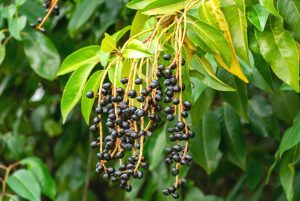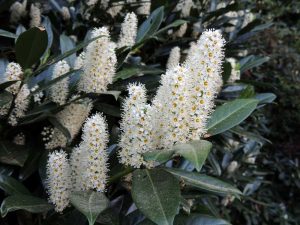 Cherry laurel description:
Cherry laurel description:
Prunus laurocerasus
(Old or other familiar names: amber laurel, common laurel, Balkan laurel)
Native to the Balkans and the Caucasus, the evergreen deciduous laurel, belonging to a group of species of plumose. Its bright, bright green, leathery leaves grow rapidly into a 5 to 6 m spreading bush. Its white, clustered flowers are highly fragrant in late spring, developing into red fruits by late summer, which later turn black. Its berries contain a poisonous compound cyanide, so do not ingest them.
Location/requirements:
Likes a sunny spot, but scorching sun will scorch the leaves, tolerates shade but will suffer and will not make a nice lush bush. Water regularly for the first two years, then water only in hot weather. Avoid damp places when planting because it is prone to fungal diseases. It doesn’t need much nutrients, but a little fertilizer in spring can do wonders. It can withstand frosts well, but young stems should be protected with mulch. If the foliage is damaged by frost, just cut it back to a healthy part and it will leaf out again.
If it thrives, it can resist disease. However, care must be taken to pinch it in time if it is attacked by fungal diseases or pests. The leaves, which yellow in patches and then turn brown with time when exposed to a lot of water, will eventually become translucent, and if the leaves have greyish-white spots with a powdery texture, then it is affected by powdery mildew. Keep watering to a minimum, spray with nettle tincture, baking soda or apple cider vinegar and remove diseased parts to stop it spreading.
 Leaf drop indicates a lack of nutrients, which can be easily remedied with a little manure or compost. The leaves may turn brown from strong sunlight, water from below and avoid getting water on the leaves. Fresh shoots and leaf bracts may be infested with the scale insect, which in severe cases can lead to yellowing of the leaves, which will fall off. Plant protection and strengthening solutions are effective against the disease.
Leaf drop indicates a lack of nutrients, which can be easily remedied with a little manure or compost. The leaves may turn brown from strong sunlight, water from below and avoid getting water on the leaves. Fresh shoots and leaf bracts may be infested with the scale insect, which in severe cases can lead to yellowing of the leaves, which will fall off. Plant protection and strengthening solutions are effective against the disease.
Better pest resistance than most other species of the genus Prunus. Susceptible to powdery mildew and root rot. Some species are susceptible to viral and fungal diseases, avoid fertilizing with organic fertilizers if possible.
Propagation:
Before planting, mix fertilizer in the pit, then place the laurel seed in it and water thoroughly. Before planting, decide whether you want to plant it as a hedge, leaving a space of 70-80 cm between them, if you don’t want to bother pruning, and give the growing bush plenty of space. You can also admire the laurel on the balcony, as it can be planted in a large box. Put pebbles as a bottom layer to create a good permeable layer, followed by nutrient-rich soil. It needs more watering and fertilising in spring.
In case of a big frost, protect the plant by wrapping the pot. Plant anytime from early spring to late autumn. Once you have found the right place for it, you should cut it back so that the laurel doesn’t waste its energy on leaves, but can use it for root development. Propagation is very easy, as it can be propagated from fruit berries, cuttings or seeds. When winter comes, the berries drop off and sprout in a few years.
 Pruning:
Pruning:
Refreshing pruning should be done in April, shaping should be done in June or September. If you want to beautify your garden with its flowers, do not cut it back regularly as the new shoots will not flower. You should take great care of the leaves as ornamental plants while shaping, as damaged leaves will turn brown. For those who don’t like to bother with pruning, it’s also a perfect choice, it doesn’t need cutting back.
Active ingredients and effects:
Homeopathic tincture is prepared according to the Homeopathic Pharmacopoeia by ethanolic extraction of fresh leaves of Prunus laurocerasus. Prunus laurocerasus leaves contain 1-2% cyanogenic glycoside. The main cyanogenic glycosides are prunazine (L – (-) – mandelonitrile-ß-D-glucoside) and sambunigrin (L (+) – mandelonitrile-ß-glucoside). About 50-210 mg of hydrogen cyanide can be released from 100 g of fresh leaves. Other constituents are essential oils (0.05%), ursolic acid (1%), flavonoids such as kaempferol and quercetin, caffeic and p-coumaric acids, enzymes such as prunase, D-oxynitrilase and ß-glucosidase, which is the sugar and cyanohydrin component of glycosides. The latter is unstable and dissociates into hydrogen cyanide and a carboxylic acid. Other constituents of the leaves are lipids (3.5%) and ash (5-7%), with traces of arsenic, copper, zinc, manganese and aluminium.
Prunus laurocerasus is poisonous. The toxicity of the plant is attributed to hydrogen cyanide released from cyanogenic glycosides. The production of hydrogen cyanide in humans and animals after ingestion of Prunus laurocerasus is partly due to hydrolytic cleavage of cyanogenic glycosides by endogenous plant enzymes, and to a greater extent to bacterial ß-glycosidases formed in the gastrointestinal tract. Hydrocyanic acid inhibits enzymes necessary for the transport of oxygen from the blood to the tissues. It has a strong affinity for cytochrome oxidase-Fe3+, forming a linkage that results in immediate inhibition of cellular respiration. The resulting lack of energy can cause disruption of the central nervous system and death results from generalised cytotoxic anoxia.
Deaths of sheep and cattle have been reported after ingestion of bay laurel leaves. Ruminants are generally more sensitive to cyanogenic glycosides because the near neutral pH in their stomachs favours the release of cyanidic acid. In mammals, the lethal dose of cyanogenic acid is generally considered to be 1 mg/kg bw. In humans, poisoning of aqua laurocerasi, an extract obtained by hydrodistillation of its leaves, has been reported. The average lethal dose of aqua laurocerasi administered orally was about 60 mg/person. In a case-control study, 17 drops of aqua laurocerasi were sufficient to induce lethal intoxication. Cyanogenic glycosides (laetrile) were found to be effective in the treatment of malignant tumours. However, due to the severe adverse toxic effects of laetrile, the drug is no longer recommended for use in cancer therapy.
Medicinal effects, uses:
As a spicy, aromatic, strong-tasting stimulant, it is(is) used in a number of preparations. It is known for its mild antispasmodic action and respiratory stimulant, some crushed leaves may cause sneezing, cyanogenic glycoside and amygdalin chemical compounds give the almond fragrance when the leaves are crushed. It is no longer used or recommended as a herb or spice.
The leaves are flavoured with milk to make an almond-flavoured drink, and small amounts were also used in the past as a seasoning. It is also used to make wine from the actual cherry fruit.
It contains the cyanogen compound amygdalin, which makes the juice and seeds of its leaves poisonous, with mild poisoning causing vomiting, headache, dizziness, restlessness, shortness of breath, tinnitus, visual disturbances and redness. In severe cases, loss of consciousness and convulsions.
Peppermint varieties:
Prunus laurocerasus‘Antonius’, copper-red young shoots growing in columns to 1,5-2 m tall.
Prunus laurocerasus‘Baumartner’, 1,5-2 m tall, bright green leaves.
Prunus laurocerasus‘Caucasica’, 3 to 5 m tall, with large, shiny green leaves.
Prunus laurocerasus ‘Mano’, low 1-1,5 m tall, slow-growing, glossy, pointed leaves.
Prunus laurocerasus‘Genolia’, 3 m tall, dark green, glossy leaves, growing in columns.
Prunus laurocerasus‘Green Torch’, 1 to 2 m tall, dark green, glossy, pointed leaves, growing in a column.
Prunus laurocerasus‘Hagar’, 3 m tall, light green, glossy leaves with a bronze tinge when shoots are still growing.
Prunus laurocerasus‘Herbergi’, 3-4 m tall, leathery dark green, shiny leaves.
Prunus laurocerasus‘Hibani’, 1-2 m tall, shoots bronze, dark green, shiny leaves 6-10 cm long.
Prunus laurocerasus‘Cleopatra’, low-growing, 1 m tall, leaves bright red when shoots are greenish-red, turning bright green with age.
Prunus laurocerasus‘Mari’, 1-2 m tall, shiny dark green leaves.
Prunus laurocerasus‘Miki’, 1,5-2 m, narrow, lanceolate leaves with serrated edges.
Prunus laurocerasus‘Mount Vernon’, 0,5 m tall, spreading variety, with broad, spear-shaped leaves with serrated edges.
Prunus laurocerasus‘Novita’, 1,5-2 m tall, shiny dark green leaves.
Prunus laurocerasus‘Magnolifolia’-Laurel laurel, 3-6 m tall, large 15 cm, dark green, ornamented by glossy leaves, tolerates drought well, does not take frosts well.
Prunus laurocerasus‘Klári’, 2-3 m tall, spreading branch-like, shiny, pointed, bright green leaves.
Prunus laurocerasus‘Rotundifolia’, up to 6 m tall, growing 30-90 cm a year.
Prunus laurocerasus‘Etna’, 1.5-2 m tall, leaves bronze when shoots are in leaf.
Prunus laurocerasus‘Otto Luyken’, 1-1,5 m tall, broad bushy species, long, lanceolate, dark green, glossy leaves.
Prunus laurocerasus‘Piri’, 1 m tall, dark green, shiny leaves.
Prunus laurocerasus‘Rotundifolia’, fast-growing, 3-6 m tall, large, glossy, bright green leaves.
Prunus laurocerasus‘Zabeliana’, spreading branches, 1-1.5 m tall, dark green, glossy, narrow leaves.
Laurocerasus officinalis Barabits Silver– Dark laurel, ideal for small gardens as it grows to 1 m tall and is adorned with 2 m wide, indigenous, variegated or white-spotted leaves.
Laurocerasus lusitanica– Portuguese laurel, a frost-sensitive species, not very widespread in our country, its beautiful red fruit is its most beautiful wedge, not to mention a food source for birds.
Their leaves vary in colour and shape. There are already laurel trees grown as bonsai, which are excellent for decorating small spaces.
Propagation
Pruning
Varieties
Medicinal properties
Source:
Andreas Wacker, Herbs in Homeopathy, ISBN:978 963 7268 71 7
Dr. János Zelenyák, The effects and use of medicinal plants
Lesley Bremnes, Spices and Herbs, ISBN:963 545 041 9
